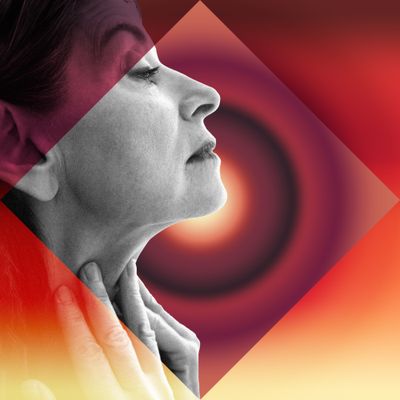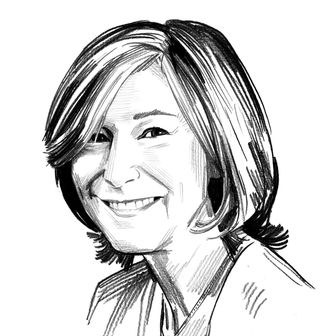
This column first ran in Valerie Monroe’s newsletter, How Not to F*ck Up Your Face, which you can subscribe to on Substack.
Something’s in the air, and fortunately today it isn’t wildfire smoke. A couple of readers recently asked about the potential benefits of exercising the above-neck area. That’s right: We’re talking about face aerobics.
Q: I know someone who does face aerobics and has incredible skin — absolutely no lines or wrinkles. (She’s 20 years younger than I am; I’m in my 60s.) Have you tried facial exercises? Do you know anyone in the 60ish age range who has seen results?
And similarly…
Q: I’m 66 and trying to take good care of myself (with healthy food, exercise, enough sleep, a skincare routine, acupuncture, herbs, and supplements by the handful). I also have active breast cancer and am taking anti-estrogen meds for the foreseeable future. My face is going south. The serums and essential oils I’m using do seem to ease the wrinkles a bit, but I wonder if my next wellness frontier is facial exercises. What do you think?
A: I think you’re taking great care of yourself, and I’m sending you a cascade of good wishes for your recovery. As for the facial exercises, though, I go from wide-eyed at your grit and determination to gimlet-eyed, my least flattering, but most familiar expression in beauty aisles everywhere.
I spoke to my old friend and plastic surgeon Alan Matarasso, who, despite his surgical gifts, doesn’t immediately dispel alternative modalities. Though he tried, he said he couldn’t find any clinical proof that facial exercises could reduce wrinkles or strengthen the face’s supportive structure. But you, dear reader, did find a study and generously sent me the link.
The study results showed that a regimen of at-home facial exercises maintained for 20 weeks did seem to improve mid-face and lower-face fullness. But it would be premature, Matarasso believes, to start working out your cheeks. He has his own reasons, but I agree with him.
For starters, the study’s limitations minimize its validity. Researchers used a small sample of middle-aged women, many of whom dropped out, and there was no control group. The women were self-selected, which means they probably had the propensity to do the exercises consistently and maybe even to find a satisfying outcome. In other words, as one dermatologist told me recently, “You can get a study to prove just about anything.”
Okay, but why wouldn’t facial exercises work?
“The face is made up of around 43 tiny muscles, each smaller than the length of the end of your pinky finger,” said Matarasso. “Working them out isn’t the same as working out your abdominals. Though facial muscles probably could get stronger, they wouldn’t hypertrophy [enlarge, in civilian speak] to the extent that, say, a larger muscle on the body would, which then stretches and lifts the skin. If there were a minute effect, it would be ridiculously labor-intensive.” In fact, Matarasso believes some repetitive movements may encourage wrinkle formation.
I noticed there’s a puckering exercise in face yoga that suggests the exact upper lip movement that seems to have deepened my perioral rhytids (the vertical lines above the upper lip). Though I don’t like them, I’m happy to say I did not get them from face yoga, but rather from my dear mother. And probably from abundant kissing. And from drinking too many thick, Awful Awful milkshakes through a straw. There are other popular face yoga exercises too, such as alleged cheek lifters, eyebrow firmers, and more, which all require some sort of repeated tapping, pinching, or lifting motions.
Matarasso concedes it’s possible that facial aerobics could temporarily increase blood flow to your complexion, but so would any aerobic activity. And good blood circulation results in a healthy, flushed effect. But you can see where we’re coming down here on this particular subject.
I wondered aloud why the idea of facial exercising might be surfacing now. “I think people might be confusing electrical stimulation devices like Emsculpt and Emface with the idea that they can achieve a similar result without a device,” he said. But alas, nope. You can read more about Emface in this post.
In the meantime, first questioner, your young friend’s complexion is more likely due to genetics and a lack of sun exposure than facial aerobics. And I’m pretty sure you already know this, but it’s worth mentioning: Comparison is the death of happiness. Let’s not do it.
Valerie Monroe was beauty director at O, The Oprah Magazine, where she wrote the monthly “Ask Val” column for nearly 16 years. Now she writes the weekly newsletter How Not to F*ck Up Your Face. Her goal continues to be to shift our thinking in the beauty arena from self-criticism to self-compassion and to learn how to be loving witnesses to ourselves and one another as we age.
More From This Series
- I’m 60 and My Retinol-Based Routine Stopped Working. What Do I Do?
- I Can’t Take My Eyes Off Donatella Versace’s New Look
- What to Do When When Eyeglasses Leave Their Mark


